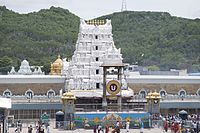|
Pancha Kshethram
 The Pancha Kshetram, (Sanskrit: पञ्च क्षेत्रम्, romanized: Pañca Kṣetram, lit. 'Five abodes/stages of Vishnu') or Pancha Bhargavi Kshethram, is a group of five Hindu temples in India which are dedicated to the deities Vishnu and Lakshmi. Their legend is associated with the Venkateswara Temple, Tirumala. Four of the temples are Divya Desams, and one is an Abhimana Kshethram. LegendDuring Kali Yuga, Narada advised sages who were performing a yagna (fire ritual) to decide who of the Trimurti (Brahma, Vishnu and Shiva) should receive its fruits. Bhrigu was sent to test the trinity. The sage, who had an extra eye in the sole of his foot, visited Brahma and Shiva without being noticed. He cursed Brahma to not be worshipped, and Shiva to be worshipped as a lingam. Bhrigu then visited Vishnu, who ignored him. Angry, Bhrigu kicked Vishnu in the chest; Vishnu apologised to the sage by massaging his feet, crushing the extra eye on the sole of Bhrigu's foot. Lakshmi considered the kick an insult, since Vishnu's chest was considered Lakshmi's residence. She left Vaikuntha, came to Earth at Kohlapura, and began meditating.[1] Vishnu took human form as Srinivasa, left Vaikuntha in search of Lakshmi, reached the Seshachalam Hills in Tirumala, and began meditating. Lakshmi learned about Srinivasa and called Shiva and Brahma, who became a cow and a calf. Lakshmi gave them to the Chola king ruling the Tirumala Hills; the cow would provide milk to Srinivasa daily while it was grazing. A cowherd in the king's household saw this, and tried to beat the cow with his staff; Srinivasa bore the injury, and struck down the cowherd. Angered by the cowherd's actions, Srinivasa made the Chola king an asura; sins committed by servants should be born by their employers. The king prayed for mercy; Srinivasa told him that he would be reborn as Akasharaja and should marry Srinivasa to his foster-daughter, Padmavati.[2] Srinivasa stayed with his foster-mother, Vakula Devi, on the Tirumala Hills. The Chola king was reborn as Akasharaja and had a foster-daughter, Padmavati (the human form of Lakshmi, who took this form in the Padmapushkarini, present-day Tiruchanur in Tirupati, Andhra Pradesh). Srinivasa married Padmavati in present-day Narayanavanam, and returned to the Tirumala Hills. After a few months, Srinivasa and Padmavati went to the seven Tirumala hills to emancipate humankind from the troubles of Kali Yuga. They became stone deities, expressing their wish to always be there. Padmavati was still angry with Vishnu. Bhrigu sought an apology and asked Lakshmi to allow him to be born in four more places: Sundararaja Perumal Temple, Salem, as Bhrigu; Nachiyar Koil as Medhavi Maharishi; Oppiliappan Temple as Markandeya Maharishi, and Sarangapani Temple as Hema Maharishi.[3][4][5] The five templesPancha Kshethram locations Venkateswara Temple, Tirumala is run by Tirumala Tirupati Devasthanams (TTD), controlled by the Andhra Pradesh government. The other four temples, in Tamil Nadu, are maintained and administered by the Hindu Religious and Charitable Endowments Department of the government of Tamil Nadu. The deities are revered in the fifth-century Tamil Vaishnavate Divya Prabandham, written by the Alvars. The temples are classified as Divya Desam except for one, which is one of the 108 Abhimana Sthalam.
References
|
Portal di Ensiklopedia Dunia




